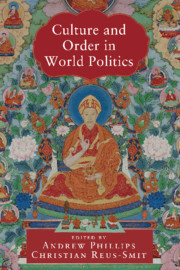Book contents
- Culture and Order in World Politics
- LSE International Studies
- Culture and Order in World Politics
- Copyright page
- Contents
- Additional material
- Contributors
- Preface
- Part I Introduction
- Part II Historical Orders
- 3 The Ottomans and Diversity
- 4 Qing and Twentieth-Century Chinese Diversity Regimes
- 5 Cultural Diversity and Coercive Cultural Homogenization in Chinese History
- Part III The Modern ‘Liberal’ Order
- Part IV Constitution and Contestation
- Part V Conclusion
- References
- Index
4 - Qing and Twentieth-Century Chinese Diversity Regimes
from Part II - Historical Orders
Published online by Cambridge University Press: 25 December 2019
- Culture and Order in World Politics
- LSE International Studies
- Culture and Order in World Politics
- Copyright page
- Contents
- Additional material
- Contributors
- Preface
- Part I Introduction
- Part II Historical Orders
- 3 The Ottomans and Diversity
- 4 Qing and Twentieth-Century Chinese Diversity Regimes
- 5 Cultural Diversity and Coercive Cultural Homogenization in Chinese History
- Part III The Modern ‘Liberal’ Order
- Part IV Constitution and Contestation
- Part V Conclusion
- References
- Index
Summary
This chapter compares the diversity regimes of the Qing Empire and twentieth-century Chinese republics to argue that evocations of 'traditional' Chinese diversity regime and interpolity relations frequent in the literature are based on a mistaken model of the Chinese past, one involving the 'tributary system' and 'Confucian peace' or tianxia concepts, largely derived from John King Fairbank’s descriptions of the 'traditional Chinese world order.'After critiquing the Fairbankian model, the chapter introduces the findings of more recent scholarship on the Qing period which reveal the flexible Qing approach to domestic diversity and interpolity relations, here called 'imperial pluralism.' The formal diversity regime of the People’s Republic of China towards its 56 minzu (nationalities, ethnicities) echoes Qing imperial pluralism as well as the nationalities system of the Soviet Union. Since the 2010s, however, the PRC has shifted from centralized pluralism towards a Han assimilationist approach. The author cautiously suggests that aspects of Chinese centralized pluralism – and not a vain quest for a homogeneous national population – would provide a more successful model, while remaining true to Chinese traditions.
Keywords
- Type
- Chapter
- Information
- Culture and Order in World Politics , pp. 71 - 92Publisher: Cambridge University PressPrint publication year: 2020
- 3
- Cited by

